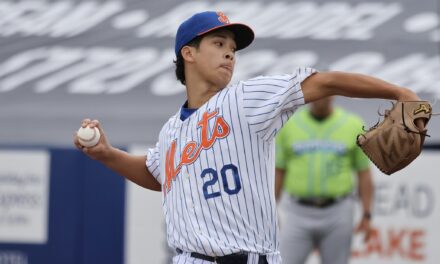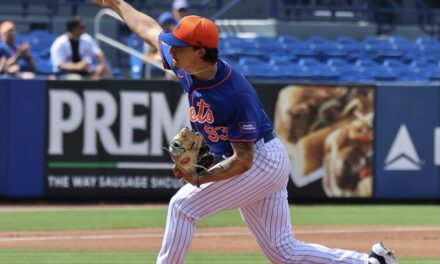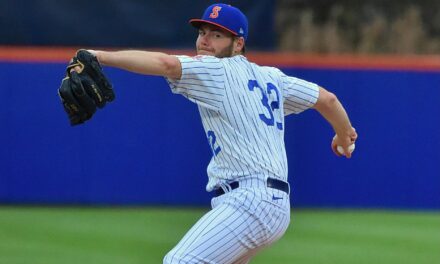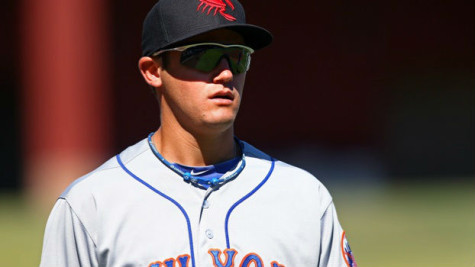
He is part of a crop of young baseball players who grew up in Las Vegas, Nevada, a class that includes the likes of Bryce Harper, Joey Gallo and Kris Bryant. He’s thoughtful, strategic and articulate and made a perfect guest on a recent WIOX, Tip-Off radio show. I’m talking about Paul Sewald the current closer out of the Binghamton Mets bullpen.
Paul Sewald comes from a baseball family. His Dad was drafted out of high school by the Boston Red Sox but choose instead to go to college as a scholarship baseball player at Loyola Marymount College. Paul and his younger brother Johnny were impact players at Bishop Gorman high school, a Las Vegas school that had not won a baseball State championship in 52 years. Bishop Gorman won their first state title during Paul’s sophomore season, followed that up with two more during his junior and senior years, then took four more in succession when Paul went off to San Diego University and his young brother Johnny was a high school baseball star.
During Paul’s senior year at San Diego and Johnny’s senior year at Bishop Gorman the talented brothers were drafted on the same day, Paul by the Mets, and Johnny by the Baltimore Orioles. Johnny choose college over professional baseball accepting a scholarship to attend Arizona State and was drafted by the Houston Astros in the spring of this year.
We asked Paul to think forward and describe what a future pitching/hitting matchup with Paul Sewald on the mound for the New York Mets and Johnny Sewald in the batter’s box for the Astros might look like.
“I know it would be pretty hard for me to keep a straight face. It would be pretty funny to face your younger brother in a major league baseball game. I haven’t faced him in years. There would be a lot of pressure on both of us for bragging rights because I’m sure into the future that matchup would come up lots. I’d like to say I would get him out. Maybe he could hit a hard line drive ball caught in the outfield so it could be a 50/50 proposition.”
On the pitching hill, Paul Sewald has been nothing short of fantastic working his way through the Mets minor league system. Out of SD University, Sewald pitched in Brooklyn for the Cyclones in his first professional season. According to Sewald there is not better baseball setting for a young prospect to begin his professional baseball career than Brooklyn’s MCU Park.
“It was pretty incredible the environment at MCU Park with all those Met fans coming out to every game. 8,000 fans consistently packed the Stadium making it exciting to come to the park every day.”
Sewald worked in 16 NY Penn League games that summer of 2012 pitching 28.2 innings with a 1.88 ERA and a 0.98 WHIP while striking out 35 and walking only 2. That’s a pretty impressive professional start, yet, amazingly, Sewald’s results have improved each year as he’s advanced up the Mets minor league ladder.
As part of Savannah’s 2013 South Atlantic League championship squad, Sewald pitched 56 inning out of the bullpen with a 1.77 ERA and the exact same 0.98 WHIP. Once again, Sewald used impeccable pitch location and control as a foundation of his pitching success fanning 67 batters while walking only 7.
That pattern of pinpoint control has held over each of Sewald’s four professional seasons. In 36 games so far in Binghamton this season, Sewald has a 3-0 record and has recorded 20 saves in 21 save opportunities with a 1.71 ERA and a minuscule 0.88 ERA. Sewald has only allowed 7 free passes while striking out 44 Double-A batters in Binghamton.
Sewald was emphatic during the interview that throwing strikes is the most important part of pitching.
“If you walk a batter, you have a zero percent chance of getting them out. You’ve handed a hitter a free opportunity to get on base,” Sewald replied with passion.
“If you watch batting practice, they throw the ball right down the middle at 72 miles per hour every single time and the batter knows what’s coming and they know where it is coming and they still hit the ball for outs. So, why wouldn’t I throw the ball in the strike zone and make a hitter prove that he can get a hit?”
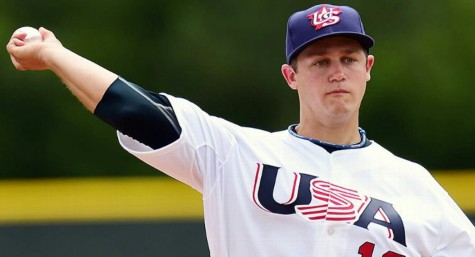
“The best hitters in baseball make outs 7 out of 10 times. Those are pretty good odds if I’m on the mound. I want to make them prove they can get a hit. I don’t know if you’ve stood in the batter’s box and tried to hit a 90 mph fastball. It’s not easy, so why wouldn’t I try to throw the ball over the plate and get outs?”
Sewald talked about the importance of control and location to pitching success. He gets a little more specific when passing along advice for youngsters wanting to learn to pitch.
“Obviously there is a little bit of difference if you throw the ball down the middle or throw it to the corners of the plate. But, if you first learn to throw it down the middle you can begin to expand a little bit and start to throw quality pitches.”
“But, for me, it’s simply throw strikes and make a hitter prove that they can hit me. For the most part, guys don’t hit a lot of doubles and home runs very often, so if you don’t walk anyone, it takes 3 singles in an inning to bring in a run.”
I told Sewald I had read where his manager in Brooklyn called him a tiger on the mound and Danny Muno emailed a friend saying they had a kid who was an animal on the mound the first time he watched Sewald pitch. I wanted Paul to respond on the importance of a mental approach for a professional baseball pitcher.
“I pride myself on that,” Sewald said. “You have to feel like – ‘I’m the best pitcher in the world’ – or how can you be. I try to go out there with a frame of mind that nobody can hit me. You’ve seem guys who go out there on the mound and they look like they’ve defeated you already by just being there. Well, maybe if I pretend to look more intimidating than I actually am, I may gain a slight advantage over hitters.”
We discussed the fact that two pitching styles dominate the mechanics pitchers use on the hill, the more old fashioned ‘drop and drive’ style of yesteryear and the more prevalent ‘tall and fall’ style of the modern age.
I told Sewald that I had watched him pitch many times in Binghamton and his style appears solidly in the ‘drop and drive’ camp. In fact, I told him his delivery made me think of Tom Seaver every time I saw him pitch, staying low and thrusting his body forward toward the plate from that low position.
Sewald had never seen film of Seaver pitch. But, when someone from college who had watched him told him that his pitching style reminded him of Seaver, he decided to find some film and check it out.
“Don’t get me wrong, i don’t throw 97 miles per hour like Seaver. But, watching the film of Seaver I can understand how people might think my delivery is like the drop and drive style that a lot of guys from that era used. I use it to my advantage. It’s very deceptive. I step across my body, and have a low three-quarter arm angle. It can be very difficult for hitters to pick up the ball. I don’t throw 94-95 mph. I throw in the low 90’s. I have to throw the ball at the knees and in and out to the edges of the plate.”
Sewald started the season as Pedro Lopez’s eighth inning bridge to closer Jon Velasquez. When Velasquez got the call to Las Vegas, Sewald took over the closer duties. Later, Sewald was chosen to pitch for the USA national team in the Pan Am games that lasted for nearly a month.
When Sewald finished his time in Toronto and returned to Binghamton, Lopez handed him the ball again in the ninth inning. I wondered if Sewald saw those roles differently.
“I try not to view them as different. Throughout my professional career I have pitched anything from the 6th to the 9th and I try to treat each situation in a similar way. The most important thing is to make sure no runs get on the board. If it’s the ninth inning and i’m pitching for a save or its the sixth inning and I’m pitching for a single out, my focus is getting the next guy out.”
“As a relief pitcher your job is to come in, throw strikes, get quick outs and make sure no runs cross. So, I try not to think about if it’s a closer’s spot versus the set-up guy. I try to make the best pitch I can to every single hitter and try to get quick outs so I’m ready to go the next day, if they need me. For me, no matter what the situation, it’s about making the best pitch, getting the quick out, and if that’s at the end of the game when I’m done, then that’s the end of the game.”
Sewald uses both a four and two seam fastball that he likes to throw to both sides of the plate. He considers his slider as his best pitch.
“I’ve gotten good enough where I can maneuver it into something that looks like a curve and something that looks more like a cutter. I use that against both lefties and righties. The change is a work in progress because sometimes its great and sometimes its terrible. It’s inconsistent. That’s something I need to work on to be a successful major league pitcher some day.”
My favorite part of the interview came at the end. I had just completed reading a book from the Clair Bee Chip Hilton sports fiction series, a gift someone had given me a few years back that I never got around to reading. Chip Hilton first appears in the book working as a relief pitcher out of the bullpen. I would read Sewald a short piece from the book and ask him to respond. Here’s an example:
My Question: Early in the book Clair Bee is describing Chip Hilton as a pitcher. Here’s what he said. “The tall, blond freshman had blinding speed, a wicked screwball, a good curve, and unusual control of a deceptive knuckleball. More importantly he had poise, confidence and self-control. Explain the role poise, confidence and self-control play in important pitching results.
Paul’s response: “They’re huge. You have to have good mound presence. Any coach I’ve ever had told me you have to work on your mound presence. Obviously, when you’re a kid you’re not as good about it – having a bad attitude, pouting, that sort of thing. But, I feel that I’ve learned to go out there with a poker face. You can’t tell whether I’m doing well or I’m doing poorly. I try to keep and even keel attitude and show self-control no matter how things are going.”
“Then I try to look confident, and I do feel confident. I feel great when I go out there. I know I’m going to dominate because I feel like the best pitcher in the world every time I go out there. I use my poise to give off a sense that I know I’m better than a hitter. And, I try to walk around and use that confidence to my advantage.”
Over four minor league season’s Paul Sewald has thrown 183 innings, all out of the bullpen in the Mets minor league system. His combined ERA is an impressive 1.82 with a 0.981 WHIP. Opposing batters have hit only .219 against Sewald over his career. The future Met reliever has struck out 215 batters while walking only 35.
Paul Sewald is a great interview, bright and articulate, a kid who brings a well defined pitching concept and approach to the mound. Poised and confident, Sewald has met every challenge presented in the Mets minor league system so far. He is eagerly looking ahead for a chance to pitch for the 51’s in front of his girl friend, family, friends and his home town Las Vegas fans. But, first comes the business of defending the Eastern League championship in Binghamton.


